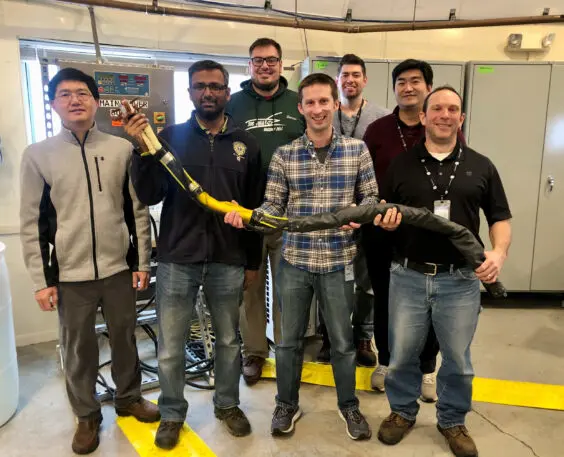Everyone who lives in an older home knows that plumbing is hell. The smallest problem involves a plumber cursing at your bathtub with a metal snake, or worse, a giant truck drilling its way through tree roots that are causing backups. You might even need to have a new pipe installed . . . simply to access your old ones! It’s as costly as it is absurd.
But what if there were something like a Roomba for keeping your piping clear? That’s exactly what’s being developed by GE Research as it debuts the Pipe-worm. It’s a long, soft-bodied robot that inches its way through pipes, just like an earthworm—while mapping its way in the dark, just like a cockroach. The tool is being designed for city infrastructure first, but could make its way into houses in the future.
“You could imagine, you put it inside your pipe and you never have to think about it again,” says Deepak Trivedi, a mechanical engineer at GE Research. “Because the robot lives there and takes care of your pipes without you ever worrying about it.”
The research is funded by DARPA, and last year, GE shared a heftier version of this robot for tunneling through the soil. The Pipe-worm, on the other hand, is imagined to serve as a critical component of our existing infrastructure, as a means to monitor, clean, and even repair sewer and fiber-optic pipeline to keep it operational.
How does it work? Instead of complicated mechanics, the Pipe-worm leverages what’s known as “soft robotics.” With a flexible, cloth body, it uses air or oil pressure to expand and contract like a long, organic muscle. (A simple pump—imagine an air mattress inflator—would sit outside the pipe to power the robot.)
By studying the movement of earthworms, the team designed its robot to inch through piping without wheels. Specifically, the magic of inching comes down to peristaltic motion, a counterintuitive geometry of muscles. When the Pipe-worm’s muscles contract, they can shrink shorter but grow wider. This phenomenon allows the front of the worm to fatten up to get a better grip on the pipe, while the rear contracts its way forward. By timing actuation between the front and back muscles, the Pipe-worm can move forward or back, and push or pull. And don’t let its soft body fool you. While it’s the size of a snake, its artificial muscles are extraordinarily strong, capable of pushing or pulling thousands of pounds. And pulling weight is important, since for now, this robot runs on a long umbilical cord that feeds it air or oil pressure. Plus, its front can be fitted with tools like a drill to break up clumps.

Yet power and durability are only part of what makes the robot so appealing. Its other important trait is autonomy—and that is inspired by the mapping capabilities of the cockroach. Cockroaches rely on two antennae to work their way through tight spaces. The Pipe-worm has antennae placed across its body. They are simple mechanisms that don’t sense all that much. All they know is where they bend. But when supercharged with a machine learning algorithm, this data is enough to allow the robot to inch its way through complicated pipe systems, turning on sharp angles and mapping inclines. You can literally put the Pipe-worm into a pipe and it won’t just figure out its own way around the system; it will draw you a map.
GE won’t detail exactly how (for competitive reasons), but the robot can live permanently in pipes, because its design doesn’t block the flow of water. As to how it fixes clogs? Because it has thousands of pounds of force, the robot can push most anything small out of the way. It can also be fitted with attachments, like a drill GE first created for soil tunneling, which can pulverize hard clogs.
The potential benefits for infrastructure are incredible. New York City alone spent $19 million last year handling aforementioned fatbergs (which, incidentally, are a combination of non-degrading “flushable” wipes, fats, and soaps that create hard chunks inside sewers). But the robot can just as easily do smaller work, too.
“One thing about this robot is it could be scaled down very easily,” says Trivedi. “This one is a meter or two long, but we could make something that’s centimeters and goes into smaller pipes.” Those smaller pipes might not be found in your city or home, but inside machinery like aircraft engines.
So when will we see the Pipe-worm make its way into our cities, or even our homes? For now, a GE spokesperson says that, “we are engaging with a number of commercial entities to evaluate the technology and are moving to pilot the technology in the coming months.”
No doubt, larger scale infrastructural applications could be more lucrative for GE. But a robot that can live inside any home’s piping to keep it clean is pretty darn appealing, too—and Trivedi suggests that GE’s commercial-focused work could bring down costs, making the robot a residential reality.
“Certainly in terms of the future, this robot is made up of materials that are mostly common and off the shelf,” says Trivedi. “As volumes increase, this could definitely become something that’s available, and very cheaply, to retail customers.”
Recognize your brand's excellence by applying to this year's Brands That Matters Awards before the early-rate deadline, May 3.